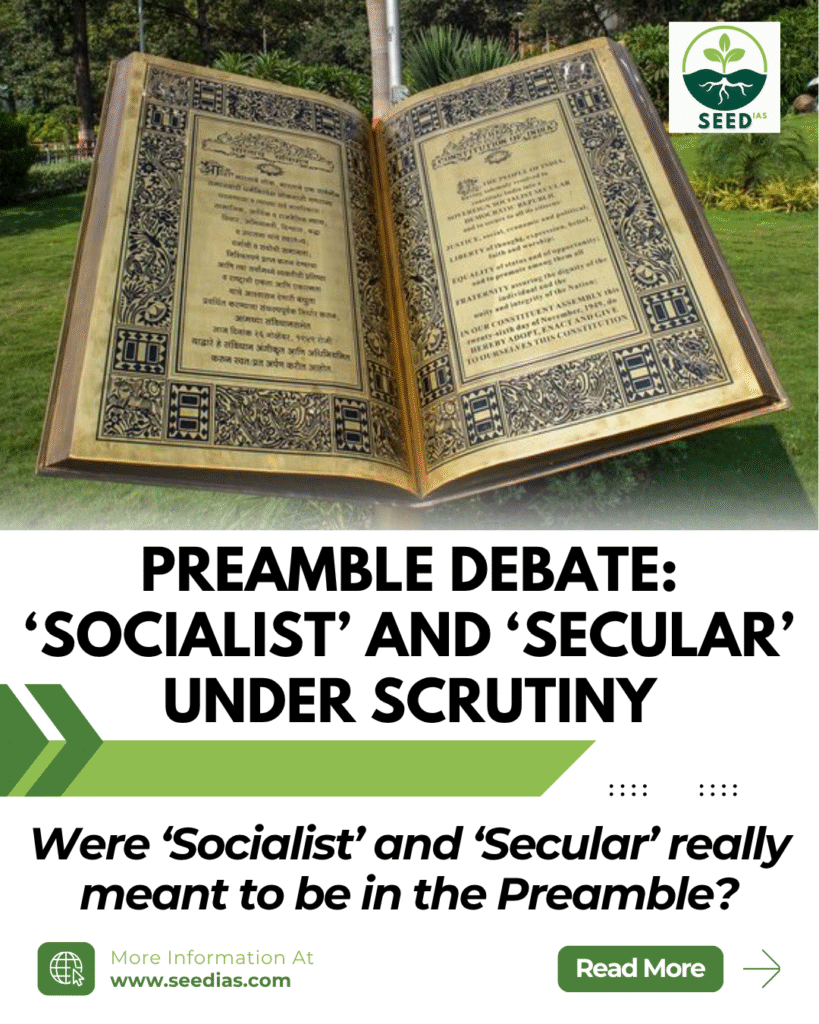Why in NEWS
A fresh debate has emerged over the inclusion of the terms “Socialist” and “Secular” in the Preamble of the Indian Constitution, which were added during the Emergency via the 42nd Amendment Act (1976). Critics argue that these additions were made without wide democratic consultation and may not reflect India’s civilisational ethos.
Key Concepts and Definitions
| Term | Explanation |
|---|---|
| Preamble | Introductory part of the Constitution outlining its ideals and objectives. |
| Secularism | State’s equal respect for all religions and its principled distance from them. |
| Socialism | State’s commitment to reduce inequalities and ensure distributive justice. |
| 42nd Amendment | Constitutional change during Emergency that added “Socialist” and “Secular”. |
| Basic Structure | Supreme Court doctrine preventing Parliament from altering core features. |
The News in Simple Terms
- The original Preamble (1950) described India as a Sovereign Democratic Republic.
- The 42nd Amendment (1976) added the words “Socialist” and “Secular”, and “Integrity” to emphasize social and religious equity and national unity.
- Critics now challenge the legitimacy and relevance of these insertions, raising issues of ideological imposition and lack of constituent assembly mandate.
Understanding Secularism in India
| Feature | Indian Secularism |
|---|---|
| Principled Distance | State remains neutral but may engage with religion for reform. |
| Non-Interference | Respects religious freedom unless it violates constitutional rights. |
| Selective Intervention | Intervenes when religion contradicts constitutional values (e.g., gender equality). |
Pre-1976 Secular Foundations in the Constitution
- Article 14, 15, 16 – Equality and no religious discrimination
- Articles 25–28 – Freedom of religion
- Article 44 – Directive Principle advocating Uniform Civil Code
Key Dilemmas in Adding ‘Secular’ Explicitly
| Issue | Concern |
|---|---|
| Ideological Imposition | Ambedkar felt Constitution shouldn’t impose fixed ideologies. |
| Symbolic Over Substance | Nehru believed secularism must be lived, not declared. |
| Alienation Risk | Fear that word “secular” could be seen as anti-religion. |
| Legislative Flexibility | Could restrict reforms in religious practices. |
Arguments in Favour vs Against the Inclusion
| In Favour | Against |
|---|---|
| Already reflected in Articles 14–28, DPSPs | Not part of the original intent of the framers |
| Judicial support – Kesavananda Bharati, S.R. Bommai, Minerva Mills | Added during Emergency under controversial circumstances |
| Affirms modern democratic values of equality and social justice | Considered alien to Indian civilisational context and organic pluralism |
| 2024 SC verdict upheld validity in Dr. Balram Singh v. Union of India | Undermines the sanctity of the original Preamble |
In a Nutshell
Memory Code: S3 – Socialist, Secular, SC-backed
- S1: Socialist – Justice via equity
- S2: Secular – Respect for all faiths
- S3: Supreme Court – Basic structure doctrine supports both
Prelims Practice Questions
- Which Amendment Act inserted the words “Socialist” and “Secular” into the Preamble?
A. 44th Amendment
B. 24th Amendment
C. 42nd Amendment
D. 52nd Amendment - Which Article deals with abolition of untouchability that reflects secular values?
A. Article 14
B. Article 17
C. Article 19
D. Article 21 - Which of the following is NOT a feature of Indian secularism?
A. Principled distance
B. Anti-religious stance
C. Non-interference
D. Selective intervention
Mains Practice Questions
- Evaluate the constitutional legitimacy and contemporary relevance of the terms ‘Socialist’ and ‘Secular’ in the Preamble of India. (GS-2, Polity)
- Compare Indian secularism with Western models. How does the Indian model reflect its unique civilisational values? (GS -2 )
Answer Key with Explanations
| Qn | Ans | Explanation |
|---|---|---|
| 1 | C | 42nd Amendment Act (1976) added ‘Socialist’ and ‘Secular’ during Emergency. |
| 2 | B | Article 17 abolishes untouchability, reinforcing the secular ideal. |
| 3 | B | Indian secularism is not anti-religion but promotes religious harmony. |
















